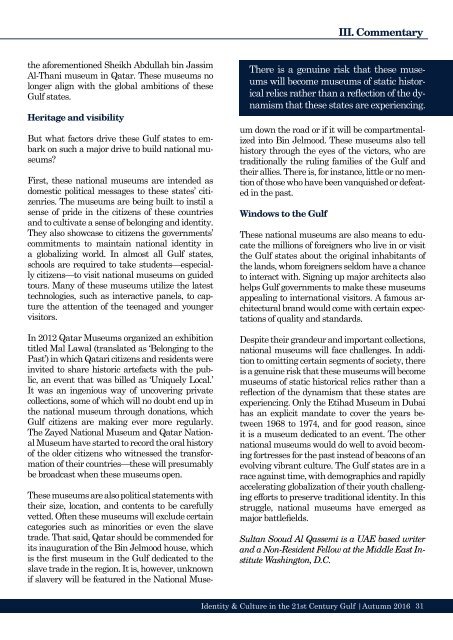Create successful ePaper yourself
Turn your PDF publications into a flip-book with our unique Google optimized e-Paper software.
III. Commentary<br />
the aforementioned Sheikh Abdullah bin Jassim<br />
Al-Thani museum in Qatar. These museums no<br />
longer align with the global ambitions of these<br />
Gulf states.<br />
Heritage and visibility<br />
But what factors drive these Gulf states to embark<br />
on such a major drive to build national museums?<br />
First, these national museums are intended as<br />
domestic political messages to these states’ citizenries.<br />
The museums are being built to instil a<br />
sense of pride in the citizens of these countries<br />
and to cultivate a sense of belonging and identity.<br />
They also showcase to citizens the governments’<br />
commitments to maintain national identity in<br />
a globalizing world. In almost all Gulf states,<br />
schools are required to take students—especially<br />
citizens—to visit national museums on guided<br />
tours. Many of these museums utilize the latest<br />
technologies, such as interactive panels, to capture<br />
the attention of the teenaged and younger<br />
visitors.<br />
In 2012 Qatar Museums organized an exhibition<br />
titled Mal Lawal (translated as ‘Belonging to the<br />
Past’) in which Qatari citizens and residents were<br />
invited to share historic artefacts with the public,<br />
an event that was billed as ‘Uniquely Local.’<br />
It was an ingenious way of uncovering private<br />
collections, some of which will no doubt end up in<br />
the national museum through donations, which<br />
Gulf citizens are making ever more regularly.<br />
The Zayed National Museum and Qatar National<br />
Museum have started to record the oral history<br />
of the older citizens who witnessed the transformation<br />
of their countries—these will presumably<br />
be broadcast when these museums open.<br />
There is a genuine risk that these museums<br />
will become museums of static historical<br />
relics rather than a reflection of the dynamism<br />
that these states are experiencing.<br />
These museums are also political statements with<br />
their size, location, and contents to be carefully<br />
vetted. Often these museums will exclude certain<br />
categories such as minorities or even the slave<br />
trade. That said, Qatar should be commended for<br />
its inauguration of the Bin Jelmood house, which<br />
is the first museum in the Gulf dedicated to the<br />
slave trade in the region. It is, however, unknown<br />
if slavery will be featured in the National Museum<br />
down the road or if it will be compartmentalized<br />
into Bin Jelmood. These museums also tell<br />
history through the eyes of the victors, who are<br />
traditionally the ruling families of the Gulf and<br />
their allies. There is, for instance, little or no mention<br />
of those who have been vanquished or defeated<br />
in the past.<br />
Windows to the Gulf<br />
These national museums are also means to educate<br />
the millions of foreigners who live in or visit<br />
the Gulf states about the original inhabitants of<br />
the lands, whom foreigners seldom have a chance<br />
to interact with. Signing up major architects also<br />
helps Gulf governments to make these museums<br />
appealing to international visitors. A famous architectural<br />
brand would come with certain expectations<br />
of quality and standards.<br />
Despite their grandeur and important collections,<br />
national museums will face challenges. In addition<br />
to omitting certain segments of society, there<br />
is a genuine risk that these museums will become<br />
museums of static historical relics rather than a<br />
reflection of the dynamism that these states are<br />
experiencing. Only the Etihad Museum in Dubai<br />
has an explicit mandate to cover the years between<br />
1968 to 1974, and for good reason, since<br />
it is a museum dedicated to an event. The other<br />
national museums would do well to avoid becoming<br />
fortresses for the past instead of beacons of an<br />
evolving vibrant culture. The Gulf states are in a<br />
race against time, with demographics and rapidly<br />
accelerating globalization of their youth challenging<br />
efforts to preserve traditional identity. In this<br />
struggle, national museums have emerged as<br />
major battlefields.<br />
Sultan Sooud Al Qassemi is a UAE based writer<br />
and a Non-Resident Fellow at the Middle East Institute<br />
Washington, D.C.<br />
<strong>Identity</strong> & <strong>Culture</strong> in the 21st Century Gulf |Autumn 2016 31


